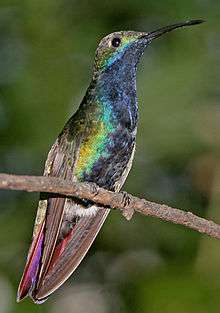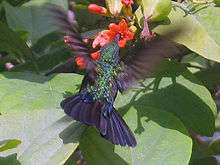Anthracothorax
The mangos, Anthracothorax, are a genus of hummingbirds in the subfamily Trochilinae.
| Mangos | |
|---|---|
 | |
| Black-throated mango, Anthracothorax nigricollis | |
| Scientific classification | |
| Kingdom: | Animalia |
| Phylum: | Chordata |
| Class: | Aves |
| Order: | Apodiformes |
| Family: | Trochilidae |
| Subfamily: | Trochilinae |
| Genus: | Anthracothorax F. Boie, 1831 |
| Species | |
|
7, see text | |
The genus Anthracothorax was introduced by the German zoologist Friedrich Boie in 1831.[1] The type species was subsequently designated as the green-throated mango (Anthracothorax viridigula).[2] The generic name combines the Ancient Greek anthrax meaning "coal" (i.e. black) with thōrax meaning "chest".[3]
Species
The genus contains seven species:[4]
| Image | Scientific name | Common Name | Distribution |
|---|---|---|---|
.jpg) | Anthracothorax viridigula | Green-throated mango | Venezuela, Trinidad and the Guianas south to northeasterm Brazil. |
RWD.jpg) | Anthracothorax prevostii | Green-breasted mango | southern Mexico south through Central America |
_-_Macho_(16247043591).jpg) | Anthracothorax nigricollis | Black-throated mango | Panama south to northeasterm Bolivia, southern Brazil and northern Argentina |
 | Anthracothorax veraguensis | Veraguan mango | Panama and Costa Rica |
 | Anthracothorax dominicus | Antillean mango | Dominican Republic, Haiti, Puerto Rico, the British Virgin Islands, and Virgin Islands, U.S.. |
 | Anthracothorax viridis | Green mango | Puerto Rico |
_male.jpg) | Anthracothorax mango | Jamaican mango | Jamaica |
- Boie, Friedrich (1831). "Bemerkungen über Species und einige ornithologische Familien und Sippen". Isis von Oken (in German). 24. Cols 538–548 [545].
- Peters, James Lee, ed. (1945). Check-list of Birds of the World. Volume 5. Cambridge, Massachusetts: Harvard University Press. p. 24.
- Jobling, James A. (2010). The Helm Dictionary of Scientific Bird Names. London: Christopher Helm. p. 49. ISBN 978-1-4081-2501-4.
- Gill, Frank; Donsker, David, eds. (2019). "Hummingbirds". World Bird List Version 9.2. International Ornithologists' Union. Retrieved 21 July 2019.
gollark: I implemented division of strings then fraction support so you can do `1 / "d" * "abcdefg"`.
gollark: Metatables are so much fun especially with `debug`.
gollark: Curse this accursed network latency! I have no idea what's causing it but it seems to be something to do with my WiFi connection.
gollark: hi.
gollark: 110592 stacks of it, anyway, give or take a few.
This article is issued from Wikipedia. The text is licensed under Creative Commons - Attribution - Sharealike. Additional terms may apply for the media files.